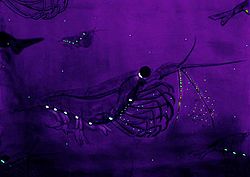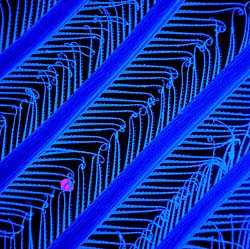User:Kils/Antarctic krill
this page frozen by faculty patronUwe Kilson June 10 2005 as teaching material for theVirtual_universityproposals "Biology of Antarctica"- for the active page goAntarctic krill- this will by updated soon again
{{Taxobox_begin | color = pink | name = Antarctic Krill}}
{{Taxobox_image | image = [[Image:Krill.jpg|200px|]] | caption = ''Euphausia superba''}}
{{Taxobox_begin_placement | color = pink}}
{{Taxobox_regnum_entry | taxon = [[Animal]]ia}}
{{Taxobox_phylum_entry | taxon = [[Arthropod]]a}}
{{Taxobox_subphylum_entry | taxon = [[Crustacea]]}}
{{Taxobox_classis_entry | taxon = [[Malacostraca]]}}
{{Taxobox_ordo_entry | taxon = [[Euphausiacea]]}}
{{Taxobox_familia_entry | taxon = [[Euphausiidae]]}}
{{Taxobox_genus_entry | taxon = ''[[Euphausia]]''}}
{{Taxobox_species_entry | taxon = '''''E. superba'''''}}
{{Taxobox_end_placement}}
{{Taxobox_section_binomial | color = pink | binomial_name = Euphausia superba | author = [[James Dwight Dana|Dana]] | date = [[1850]] }}
{{Taxobox_end}}
Antarctic krill(Euphausia superba[1]) is a species ofkrill(Arthropoda/Crustacea/Malacostraca/ found inAntarcticwaters in theSouthern Ocean.
Krill live in large and dense schools (swarms) (up to 20 000 individuals per cubic meter) and convert theprimary productiondirectly into a relatively large animal[2][3]:they grow to a length of 6 cm, weigh 2 grammes, and live probably for 6 years. The step between predator and prey is unusually large, normally it takes 3 or 4 steps from the 20micrometersmallphytoplanktonto organisms of krill size (viacopepodsand smallfish). The next size-step in thefood chainto thewhalesis also enormous, aphenomenonof theAntarctic ecosystemwhich is found nowhere else in the world.
Geographical Distribution

Krill is thronging the surface waters of the Southern Ocean, has a circumpolar distribution with highest concentrations in the Atlantic sector. The Antarctic convergence defines more or less the northern boundary. That is the circumpolar front where the cold Antarctic surface water submerges below the warmer subantarctic waters.
The Southern Ocean with its Atlantic, Pacific and Indian sectors stretches from the polarfront at ca. 55 degree South to the edge of the continent, covering 32 million square kilometers. That is 65 times the size of the North Sea. Whereas during winter more than three fourth are covered by ice, vast areas (24 million square kilometers) become icefree in South summer. The water temperatures are between - 1.3 and 3 degree Centigrade.
The waters of the Southern Ocean form a system of currents. In the West Wind Drift the surface strata is traveling round Antarctica eastwards. Close to the continent the East Wind Drift runs counterclockwise. At the front between both large eddies develop, for example in theWeddell Sea.
Position in Antarctic ecosystem
Antarctic krill is the keystone species of the ecosystem ofAntarctica,and is an important food organism forwhales,seals,Leopard Seals,fur seals,Crabeater Seals,squid,icefish,penguins,albatrossesand many otherbirds.E. superbalives only in theSouthern Ocean,in the NorthAtlantic,Meganyctiphanes norvegicaand in thePacific,Euphausia pacificaare dominant species.
Systematic
The ordereuphausiaceaare shrimplikeeucarida,whose carapax is joined with all thoracomers and so short on the sides that the gills are visible. None of the thoracopods is formed into a gnathopod, differentiating this order against thedecapoda.
Biomass
Their biomass is estimated to be between100 and 800 milliontonnes,makingE. superbathe most successful animal on theplanet;for comparison, the total non-krill yield from all world fisheries is about 100 million tonnes per year. Why can krill build up such a high biomass? The waters around the icy continent harbors one of the most giganticplanktonassemblages of our world, maybe the biggest one of all. It is so full ofphytoplanktonbecause here water rises from the depths to the light flooded surface, bringingnutrientsfrom all oceans back to thephotic zone.There are fears that the biomass is declining rapidly over the last decade, probably caused by the reduction of thepack icezone as a consequence ofglobal warming.The juveniles need apparently the ice for good survival. They hide in the caves and harvest the surface. In years with low ice conditions krill is substituted bysalps.
Fisheries

The fishery of krill is on the order of 90,000 tonnes per year. The products are used in Japan and for feeds. Krill fisheries are difficult in two aspects: Because a krill net needs to have very fine meshes it has a very high drag, producing a bow wave, deflecting the krill to the sides. Also fine meshes clog very fast. A fine net is also a very delicate net, and the first krill nets exploded while fishing through the schools. Another problem is how to bring the catch on board.
During hauling of the full net out of the water the organisms compress each other, and much juice is lost. Experiments are carried out to pump krill, still in water, through a large tube on board. A special krill net is under development too. The processing of the krill has to be very quick because it deteriorates within a few hours. One goal is to split the muscular hind part from the front part and to separate the chitin armor, in order to produce frosted products and concentrate powders. Its high protein and vitamin content makes krill interesting for direct human consumption and for the animal-feed industry.

The gut ofE. superbacan often be seen shining in green through its transparent skin, an indication that this species feeds predominantly onphytoplankton,e.g.diatoms,which it filters from the water with a "feeding basket"[4],but they can also catchcopepods,amphipodsand other smallzooplankton.Krill is calledlight-shrimpbecause it can produce light with light-organs (bioluminescence), one pair at the eyestalk and the hips of the 2nd and 7th thoracopods and single ones at the four pleonsternites. These lightorgans transmit from time to time a yellowgreen light for 2 to 3 seconds and are so highly developed that they can be compared with a torchlight: A concave reflector in the back and a lens in the front guide the produced light, and the whole organ can be rotated by muscles.The function of this light is not quite clear, some argue they compensate their shadow so that they are not visible for predators from below, others speculate it is important formatingorschoolingat night.
Development

Main spawning time of krill is from January to March, over the shelf, but also in oceanic areas over deep waters. As typical for euphausiaceans the male attaches a sperm package to the genital opening of the female. For this purpose the first pleopods of the male are constructed as tools. According to the classical hypothesis of MARR 1962, which he derived from the results of the great Discovery-Expedition, the development is this:Gastrulationsets in during the descent of the 0.6 mm eggs, on the shelf at the bottom, in oceanic areas in depths around 2000 m. From the egg hatches the 1stnaupliusand starts the migration towards the surface with the aid of its three pairs of legs ( "developmental ascent" ). The next two larval stages, 2nd nauplius and metanauplius, do not eat but are nourished by the yolk. After three weeks the little krill has finished as 1st calyptopis the ascent. Growing larger additional larval stages are following (2nd and 3rd calyptopis, 1st to 6th furcilia). They are characterized by increasing development of the additional legs, the compound eyes and the setae. At 15 mm the juvenile krill resembles the habitus of the adults. After two, maybe three years krill reaches maturity. As characteristic for all crustaceans krill must molt in order to grow. Approximately every 13 to 20 days krill ejects from its chitin skin and leaves it as exuvia behind.

How can they achieve to utilize directly the minutephytoplanktoncells (no other higher animal of krill size can do such)? They developed in their front legs a very efficient filtering apparatus: Slow motion movie (300 frames per second) ofpump filteringof the feeding basket formed by the sixthoracopodsshown by krill collectingphytoplanktonfrom the open water. The krill is hovering at a 55 degree angle at the spot. This behavior is shown under very high phytoplankton concentrations. In lower food concentrations the feeding basket is pushed through the water over half a meter in an opened position, like indicated in the watercolor sketch.
Detail of thefilterformed by thethoracopods.Like a comb longsetaestretch forwards to cover over the gap between thethoracopods.
The first degreefilter setaecarry in v-form two rows of second degreesetae,pointing towards the inside of thefeeding basket(electron microscopeimage). To display the total area of this fascinating structure one would have totile7500 times this image.
Into these gaps are then third degree setae reaching half the distance. In some parts of the net the openings are only 1micrometerwide (electron microscopeimage).
Icealgae raking
Krill can scrape off the green lawn ofice algaefrom the underside of thepack ice[5].In this image, taken via aROV,most krill swim in an upside-down position directly under the ice. Only one animal (in the middle) ishoveringin the free water.

Krillevadespredatorsby very fast backward swimming (lobstering), flipping itstelson.They reach speeds of over 60 cm per second. Thetriggertime to opticalstimulusis, in spite of the low temperatures, only 55 milliseconds.
The compound eye

Literature
MARR J W S 1962 The natural history and geography of the Antarctic KrillEuphausia superba- Discovery report 32:33-464
External links
- "Virtual microscope"of Antarctic krill for interactive dives into their morphology and behavior, along with other peer-reviewed information
- free publications and high resolution images onWikisource




